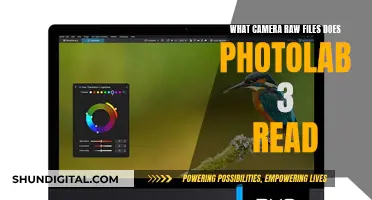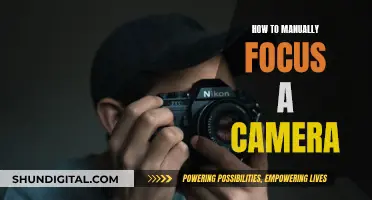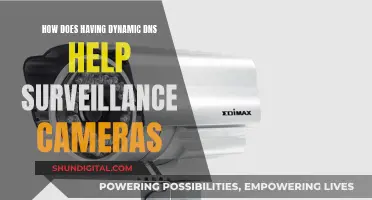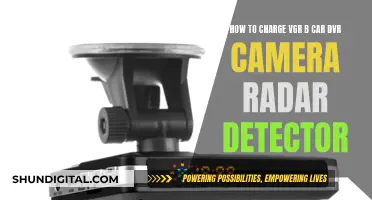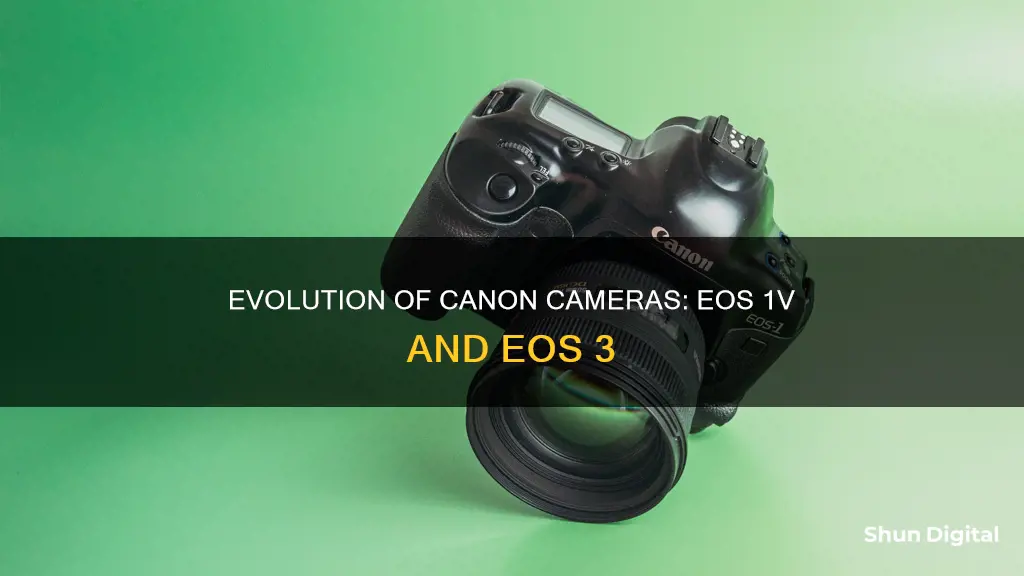
The Canon EOS 1V and EOS 3 are both 35mm single-lens reflex cameras from Canon's EOS series. The EOS 3 was introduced in late 1998, while the EOS 1V was released in 2000. Both cameras feature a 45-point autofocus system, although the EOS 3 was the first to debut this technology. The EOS 1V is considered the top-of-the-line 35mm SLR from Canon and was widely used by professional photographers for sports and news photography until DSLRs took over. The EOS 3, on the other hand, was Canon's most technologically advanced film SLR design at the time of its release and offered features such as wireless E-TTL flash and a 21-zone metering system.
| Characteristics | Values |
|---|---|
| Release Date | EOS-3: November 1998 |
| EOS-1V: 2000 | |
| Type | Both: 35mm film single-lens reflex camera |
| Target Users | Both: Professionals and advanced amateurs |
| Accessories | Both: Motor-drive and battery pack mostly interchangeable with EOS-1N |
| Autofocus System | EOS-3: 45-point autofocus system |
| EOS-1V: 45-point autofocus system | |
| Eye-Control System | EOS-3: Refined version of the Eye-Control system of the EOS-5 |
| EOS-1V: Not featured | |
| Shutter Unit | EOS-3: Passed 100,000 shutter cycles |
| EOS-1V: Specified to withstand at least 150,000 shutter cycles | |
| Flash Metering | EOS-3: E-TTL flash metering for use with the EX series of external Canon flash units |
| EOS-1V: Not specified |
What You'll Learn

The Canon EOS-1V was released in 2000, two years after the EOS 3
The Canon EOS-1V is a 35mm single-lens reflex camera from Canon's EOS series, released in 2000. It was the last model of Canon professional film cameras before it was discontinued on May 30, 2018. The EOS-1V was the fastest moving-mirror film camera ever put into production at the time, reaching 10 frames per second with the PB-E2 power drive booster and the NP-E2 Ni-MH battery pack.
The EOS-1V was released two years after the Canon EOS 3, which was introduced in November 1998. The EOS 3 is a 35mm film single-lens reflex camera for professionals and advanced amateurs. It was Canon's most technologically advanced film SLR design at the time, and the first to debut the 45-point autofocus system, wireless E-TTL flash, and 21-zone metering system, which were later used in the EOS-1V and early 1D models.
The EOS 3 and EOS-1V share many similarities, including the same form factor, controls, and accessories. The EOS 3 inherited a refined version of the Eye-Control system of the EOS-5, which allowed users to select one of the 45 autofocus points by looking at it through the viewfinder. This feature was not included in the EOS-1V. The EOS 3 also had a higher shutter endurance, passing Canon's standard endurance tests of 100,000 shutter cycles, compared to 150,000 for the EOS-1V.
In terms of build quality, the EOS-3 is constructed of glass-fiber reinforced polycarbonate with aluminum inserts and exterior panels of rigid engineering plastic. On the other hand, the EOS-1V has a durable metal chassis and a magnesium alloy outer body shell, making it one of the most reliable cameras ever made. It also has environmental seals, high-grade components, and heavy-duty construction, giving it a solid and professional feel.
Both cameras have extensive features and specifications, catering to professional and advanced amateur photographers. The EOS-1V includes various exposure modes, shutter speeds up to 1/8000 of a second, a self-timer, multiple focusing modes, autofocus focusing points, and interchangeable focusing screens. The EOS 3 offers similar capabilities, with additional features such as Eye-Controlled Focus and custom functions for personalized settings.
Overall, the Canon EOS-1V, released in 2000, built upon the foundation laid by the EOS 3, released two years earlier, refining and improving various aspects to create one of the best film cameras ever made.
Replacing Li-ion Camera Batteries: A Step-by-Step Guide
You may want to see also

The EOS 3 was Canon's most advanced film SLR design at the time
The Canon EOS 3, introduced in November 1998, was the company's most advanced film SLR camera at the time. It was designed for professionals and advanced amateurs, offering a range of innovative features.
The EOS 3's standout feature was its autofocus system, which utilised 45 AF sensors to deliver fast and accurate focus. This system, known as Eye Controlled Focus, allowed the camera to predict the correct AF sensor to use by reading the user's mind. This resulted in a more intuitive and seamless shooting experience. Additionally, the EOS 3 offered a high-speed shooting mode of 7 fps, a sturdy build, and compatibility with a wide range of EF lenses and accessories.
The camera's design was based on the EOS 1N, retaining its sturdy construction and easily accessible controls. The EOS 3 also incorporated improvements suggested by EOS-1N and EOS 5 users, reflecting the latest trends in the SLR industry. It offered a high level of protection against moisture and dust, similar to the EOS-1N, and featured a silent film rewind function.
The EOS 3's autofocus system, with its 45 AF points, was later adopted by Canon's EOS-1V, EOS-1D, and subsequent professional SLR models. The EOS 3's Eye Controlled Focus feature, however, was not carried over to the EOS-1V. Overall, the EOS 3 represented a significant step forward in Canon's SLR technology, offering a combination of advanced features and ease of use that made it a popular choice for both advanced amateurs and professionals.
Unlocking Portrait Mode: Capturing Professional Photos on Your Mobile
You may want to see also

The EOS 1V is a top-of-the-line 35mm SLR camera
The EOS 1V was the successor to the EOS-1N and is a premier-class professional SLR featuring the latest state-of-the-art technology. It has 45-point autofocus, giving predictive AI servo AF at about 9 FPS (with the PB-E2 attached) for outstanding subject tracking and blazingly fast focusing, all automatically. It has a high-speed continuous shooting of 10 FPS (with the PB-E2 attached). The EOS 1V is water and dust resistant, with strong, rigid magnesium alloy outer covers that easily passed 150,000 operations test standards. It has a 1/8000 sec high-speed shutter that syncs with flash at 1/250 second. The EOS 1V has a shooting data recording system, with shooting data for 100 rolls of 36-exposure film (using the standard settings) stored in memory, and can be read and edited on a computer using the ES-E1 software.
Charging Your Kodak 12MP Camera: A Step-by-Step Guide
You may want to see also

The EOS 3 is lighter than the EOS 1V
The Canon EOS 3 and the Canon EOS 1V are both 35mm film single-lens reflex cameras. The EOS 3 was introduced in November 1998, while the EOS 1V was introduced in 2000. The EOS 3 is the predecessor to the EOS 1V, and as such, the EOS 1V has several improvements over the EOS 3. However, one aspect in which the EOS 3 is superior to the EOS 1V is weight.
The EOS 3 is a "plasticky consumer camera", while the EOS 1V is a "precision metal work of art". The EOS 1V is a "ruggedized, solid-magnesium-alloy" camera, and as a result, it is heavier than the EOS 3. The EOS 1V weighs 33 oz. (945 g) without batteries, while the EOS 3 weighs 2.23 kg with the PDBE1 battery pack. The EOS 1V is also heavier than other comparable cameras, such as the Nikon F5 and the Leica M4.
The weight of the EOS 1V is a significant factor when considering its portability. For example, one user mentions that the weight of the EOS 1V is something to consider when "bushwalking and travelling". However, some users argue that the weight of the EOS 1V is not an issue, and that a heavier camera can actually be beneficial as it provides more stability when hand-holding the camera.
Overall, while the EOS 1V offers several improvements over the EOS 3, the EOS 3 is lighter and therefore may be a better option for those who prioritise portability.
Xomodo Wireless Cameras: How Long Does the Charge Last?
You may want to see also

The EOS 3 has a more user-friendly interface than the EOS 1V
The Canon EOS 3 and EOS 1V are both 35mm film single-lens reflex cameras, with the EOS 3 aimed at professionals and advanced amateurs, and the EOS 1V marketed as Canon's top-of-the-line 35mm SLR. The EOS 3 was introduced in 1998, and the EOS 1V in 2000.
The EOS 3 has a Quick Control Dial (QCD), which can be used to quickly adjust exposure compensation, aperture, and other settings. However, the EOS 1V also has a similar feature with its "Registered AF Point" button, which allows you to easily move between different AF points.
The EOS 3 has a bright viewfinder with a magnification of .72 and 97% viewfinder coverage. The EOS 1V also has a clear and bright viewfinder, with the added benefit of AF points that light up only when needed and then disappear.
The EOS 3 introduced the 45-point autofocus system, which was later used in the EOS 1V and other Canon professional SLRs. However, the EOS 3's Eye-Control system, which allowed users to select one of the 45 autofocus points by looking at it through the viewfinder, was not carried over to the EOS 1V. This feature worked well for some users but could be inconsistent and was not suitable for those wearing glasses or contact lenses.
Overall, while both cameras have their pros and cons when it comes to user-friendliness, the EOS 3's combination of push-button menus and Eye-Control autofocus may make it slightly more user-friendly for those who can make the latter feature work well for them.
Eufy Camera Battery Life: How Long Do They Last?
You may want to see also
Frequently asked questions
The Canon EOS 3 was the first to be made, released in 1998.
The Canon EOS 3 is a 35mm single-lens reflex camera.
The Canon EOS 3 has a 45-point autofocus system.
The Canon EOS 1V was released in 2000.
The Canon EOS 1V is a more rugged, metal version of the Canon EOS 3, which is made of plastic. The EOS 1V also does not have the EOS 3's mind-controlled autofocus.


